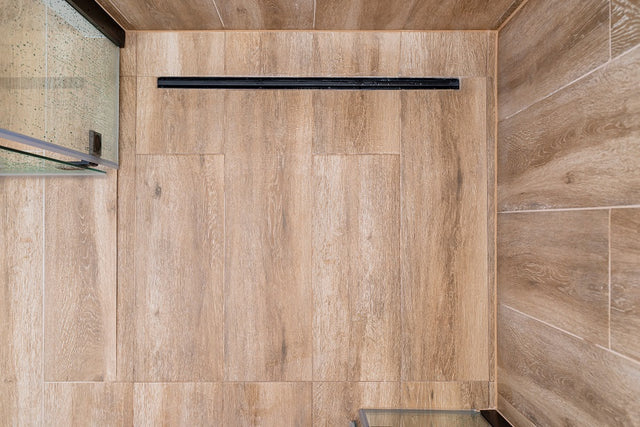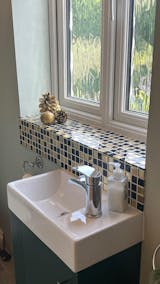At what distance from the wall should a linear wall drain be installed?
Installing a linear wall drain is one of the increasingly popular solutions during bathroom renovation. However, many wonder what distances should be maintained from the wall to ensure the drain functions correctly and does not cause problems. In this article, we will discuss the factors that influence the distance from the wall and how to choose it to guarantee that the drain works efficiently and without faults.
At what distance from the wall to install the drain: important information
Important information about the installation distance of the linear drain in the bathroom will help you avoid problems with its operation. It is worth paying attention to several factors that influence the choice of the appropriate distance.
First of all, we remind you that this distance depends on the thickness of the tiles covering the bathroom floor. The distance usually recommended from the wall is 20-25 cm, but in the case of thinner tiles, this distance can be as little as 10 cm.
Another factor that influences the distance is the inclination angle of the linear drain. According to manufacturers' recommendations, this angle should be about 2-3 cm per meter. In the case of shorter pipe sections, this angle should be slightly greater to ensure proper water drainage.
You should also pay attention to the position of the walls where the drain installation is planned. If the wall is not flat, this could affect the distance to be maintained. In such a case, it is worth consulting a specialist.
is also important to choose the right material for the installation. Linear drains must be installed in a stable and secure manner. Therefore, it is important to use appropriate materials, such as strong adhesives and filling mortars.
Linear discharge – what are the advantages of this solution?
The linear drain is an increasingly appreciated solution used in bathrooms. Its advantages are related to functionality and aesthetics. Here are some reasons why you should consider installing a linear drain in your bathroom.
First of all, a linear drain allows for a uniform surface on the bathroom floor, enhancing its aesthetics and making cleaning easier. Thanks to this solution, it is no longer necessary to use traditional round drains, which could pose an obstacle for bathroom users, especially the elderly and disabled.
The linear drain is also characterized by greater efficiency compared to traditional point drains. Thanks to this, water flows away more quickly and the risk of flooding the bathroom is much lower. A linear drain also facilitates maintaining hygiene in the bathroom because there is no space for bacteria and mold.
Another advantage of the linear drain is its versatility. Thanks to this solution, you can design your bathroom as you prefer, without the limitations of traditional round drains. It can be installed in both traditional and modern bathrooms, as well as in bathrooms with unusual shapes.
A linear drain can also be a decorative element in the bathroom. It is available in various options, including stainless steel, brass, and even glass. You can also choose a drain with additional features, such as backlighting or a water filtration system.
Linear drain types: what options are available?
A linear drain is an increasingly popular solution in bathrooms, and manufacturers offer many different types of such drains to suit the individual needs and requirements of customers. Here are some examples of the types of linear drains available on the market.
The first type of linear drain is an open inlet drain. It is a traditional type of drain, easy to install and relatively inexpensive. The bath water stops on a grate placed above the drain pipe. This drain works well in smaller bathrooms where a high drainage capacity is not required.
The next type is a drain with a closed inlet. The water is collected in a special tank, which makes this drain more efficient than a drain with an open inlet. This drain can be equipped with a filtration system that removes impurities from the water and prevents clogging of the drain.
The drain with a linear siphon is another type that is becoming increasingly popular. It is characterized by high efficiency and an elegant appearance. The siphon is positioned along the entire length of the drain pipe, thus preventing odors from wastewater. The drain cover with a linear siphon is easy to clean and maintain.
Linear drains with a closed drainage system are another popular option. This type of drain allows for effective water drainage from high-intensity surfaces, such as showers or pools. The closed drainage system prevents dirt and sand from entering the drain pipe.
The last type of linear drain worth replacing is one with LED backlighting. This type of drain is becoming increasingly popular due to its functionality and aesthetic values. The LED backlighting creates effective lighting in the bathroom, adding an additional decorative element.
Linear distance of the drain from the wall: how to measure it?
Choosing the appropriate distance of the linear drain from the wall is a fundamental element for the proper functioning of the bathroom. To ensure correct and fault-free operation of the drain, maintain an adequate distance from the wall. How is this possible?
First of all, we remind you that this distance depends on the thickness of the tiles covering the bathroom floor. The distance usually recommended from the wall is 20-25 cm, but in the case of thinner tiles, this distance can be as little as 10 cm.
To measure distances accurately, you can use special tools such as a ruler or a tape measure. If you don't have such a tool, you can use a tape measure or a piece of string.
is also important to maintain the proper slope angle of the drain pipe. According to manufacturers' recommendations, this angle should be about 2-3 cm per meter. In the case of shorter pipe sections, this angle should be slightly greater to ensure proper water drainage.
You should also pay attention to the position of the walls where the drain installation is planned. If the wall is not flat, this could affect the distance to be maintained. In such cases, it is worth consulting a specialist.
Ultimately, it is important to remember that choosing the appropriate distance from the wall is a fundamental element for the proper functioning of the linear drain. Placing the drain pipe too close to the wall can cause water drainage problems and make it difficult to maintain hygiene in the bathroom. On the other hand, an excessive distance from the wall can compromise the bathroom's aesthetics. It is advisable to pay attention to these factors also during the design and installation of a linear drain in the bathroom.
Linear drain – a proven solution for every bathroom
A linear drain is a proven solution that is becoming increasingly popular among bathroom designers and users. It is characterized not only by its aesthetic appearance but also by its high efficiency and ease of cleaning. The various types of linear drains available on the market allow it to be adapted to the individual needs and requirements of users, as well as to the characteristics of a specific bathroom. It is definitely worth considering the installation of a linear drain to enjoy the comfort and practicality of bathroom use for a long time.
















0 Comments
There are no comments for this article. Be the first one to leave a message!